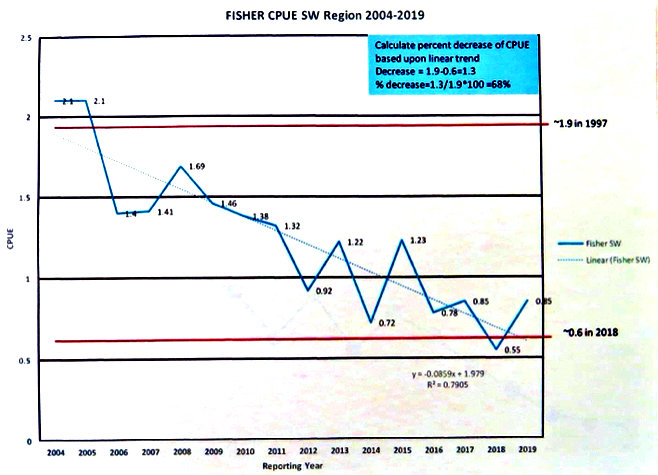This report was prepared by Meade Cadot, Ph.D. on behalf of New Hampshire Wildlife Coalition and submitted as testimony to the New Hampshire Fish and Game Commission. Download the full report.
In 2001 the fisher harvest was 1007 and the catch per hundred trap nights was 3.16 The Red Fox harvest was 409, and the Gray Fox harvest was 183. The second paragraph of the 2001/02 NH Wildlife Harvest Summary for Furbearers begins with the following: “New Hampshire furbearers remain abundant and widespread, as indicated by the 2001 New Hampshire trapping season.” That same sentence is repeated verbatim in the second paragraphs of the furbearer harvest summaries in 2002/03, 2003/04, 2004/05, and 05/06 in spite of the fact that the fisher harvest fell to 530 and the catch per hundred trap nights fell to 2.22. The Red Fox harvest was down to 191 and the Gray Fox to 64. How do these downward trends demonstrate that furbearers “remain abundant and widespread”? The 2005/06 report states the following about the fisher situation: “The fisher harvest was 530, a decrease of 29 percent from 749 in 2004 and was 34 percent below the 5-year average. …Past analysis of long-term fisher harvest data suggests that the population can sustain an annual harvest of approximately 1,100 animals.” Clearly that analysis was faulty at best, very misleading and, in reality, ridiculous! There wasn’t even an attempt to provide any scientific support for this conjecture. The harvest hasn’t been as high as 1,100 since 1997, and it has been below 800 since 2004, below 400 since 2007, and below 100 since 2016.
In the 2008/9 summary, the second paragraph begins with “Results from the 2008/9 New Hampshire trapping season reflect that New Hampshire furbearers are widespread and abundant.” These exact same words are used to begin paragraph two of the summary reports for 2009/10, 2010/11. 2011/12, 2012/13, 2013/14, 2014/15, 2015/16,2016/17, and 2017/18. The 2008/9 summary also states the following: “The 2008/9 fisher CPUE held constant at 1.63 in 2007/08 and 1.64 in 2008/9 (Table 2) suggesting that the population had stabilized. While several species experienced declines in their CPUE index this past season, these declines were within historic norms.”
There is no mention of fisher (or foxes) in the summary report paragraphs for 2013/14, 2014/15 or 2015/16. In all three reports, the third paragraphs are the same, word for word, as follows: “The New Hampshire furbearer management program relies on trapper data to monitor furbearer populations and to develop season proposals. While trends for other species have varied, declines and increases are within historic norms.” Trends for other species? What other species?? The decline of the fisher since 2001 is certainly not within historic norms. Between 2001 and 2008 the fisher harvest declined precipitously from 1,007 to 387, with CPUE dropping from 3.16 to 1.63 And the trends continued. In 2015, the reported harvest was down to 140 and the CPUE down to just 1.13! Clearly the population had not “stabilized”.
Management adjustments since 2015 have failed to reverse that downward trend. For the last two years reported, the harvest has averaged just 46 and the CPUE still only 1.13.
As I stated in my comments submitted four years ago, the 6 year study in South Central Maine by the Maine Cooperative Research Unit utilizing 76 radio-collared fishers showed that where trapping is permitted, it is the major cause of fisher mortality–in that study, an eye catching 80% (Krohn 1993)! The trapping regulations for taking fisher in New Hampshire over the last 2 decades have clearly been far too liberal with season bag limits as high as 15 per trapper.

It’s not that NHFG isn’t aware of the situation. Back in 2015 in the New Hampshire Fisher Assessment by Patrick Tate, the executive summary states, “Beginning around 2005 fisher populations began to decrease in some parts of the state and neighboring New England states report similar trends.” I have checked with furbearer managers in Vermont and Maine and neither of their populations have experienced the precipitous decline that our population has. The same is true for Massachusetts –though there, only live box traps are allowed, so the state’s harvest numbers are not as directly comparable. In Tate’s assessment under the heading “Harvest Management” he stated, “Differential harvest vulnerability among males and females and among age cohorts can be evaluated as measures of harvest intensity. Adult males and juveniles are more vulnerable to harvest than adult females and are underrepresented in the harvest sample during low exploitation…The harvest sex ratio also provides a measure of population-based harvest intensity as the ratio of yearling females to yearling males will generally be skewed towards females in heavily trapped populations.” So…why is it that New Hampshire did not start mandating lower jaw turn-in for age determination 5 years ago! The harvest now will very likely yield samples too small for meaningful statistically significant analysis.
As was done in the mid 1970s, the season should again be closed for the biennium. At the very least, the season should be closed in the Southwest Region where the decline in the harvest has been the most severe.
Thank you for your consideration.